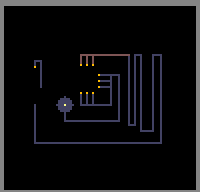Element:ARAY
 Ray Emitter. Rays create points when they collide. | |
| Properties | |
|---|---|
| Section | Electronics |
| Spawn temperature | 22°C |
| Heat Conductivity | 0% |
| Relative weight | 100 |
| Gravity | 0 |
| Acid dissolve rate | 0.1% |
| Flammability | 0 |
| State | Solid |
| Misc properties | |
| Source code | |
Contents
Reactions
Can receive a SPRK from all of the electric conductors, even SWCH. It creates a line of the element BRAY in the direction opposite to the side it was sparked from. Unlike other electronics, ARAY must receive a SPRK from a pixel in direct contact with it.
The temperature of the BRAY is the same as the temperature of the ARAY that created it.
The BRAY can also have different properties depending on what was used to spark it. If ARAY is sparked with PSCN instead of any other conductor, the BRAY only stays for a couple of frames, removes other types of BRAY, looks orange and has tmp of 2. If ARAY is sparked with INST the resulting beam will go through most conductive materials SPRK'ing them all the way. Note, that the beam of BRAY will not be created if a non-transparent particle is directly in front of it (Including metals for INST). By transparent I mean any particle that BRAY can pass through. Those materials are covered below.
Detailed usage
ARAY is an indestructible element in the Electronics group, it can receive a SPRK from all of the electric conductors and SWCH. It creates a line of the element BRAY in the direction corresponding to that which it was sparked from (e.g if the spark hit the left edge of the ARAY, the BRAY would emanate from the right edge). To spark ARAY, the conductor must touch the ARAY particle, unlike between other conductors where the spark can jump over a space of 1 pixel. More than anything, ARAY is creator of the element BRAY, which will be described in depth here.
BRAY
BRAY is the byproduct of ARAY being SPRK'ed by any metal. It is an element that doesn't show in the menu, it is created from SPRK'ed ARAY. Its color is determined by the ratio between the colors on the 30 bit color spectrum. It can hold a 30 bit number and, by default (unless it was created by PSCN), all 30 bits are set giving it its white appearance. You can use FILT to set that value to something different or preform a bitwise operation on it.
The BRAY element rapidly fades after its creation with a life of 30 frames. One way to make it "drawable" is using the particle picker in the "Tools" section. The default way to use the part picker is by pressing down with your scroll wheel or by clicking on it with the left mouse button while holding the Alt button. Unlike neutrons and photons, BRAY passes through all wall elements. It will go off the edge of the screen unless it hits a non-transparent particle. If BRAY hits a conductor, such as METL, then the element gets SPRK'ed. BRAY can also go through ARAY which is useful if you want to spark a PSCN with ARAY pointing right back at it.
If two lines of BRAY collide, they create a 'solid' BRAY at the point which will fade slowly with a life of 1020. When a BRAY fires into another BRAY it will turn into 'solid' BRAY. The 'solid' BRAY is unique in that it is also transparent. So while BRAY is normally not transparent, it will become transparent when they create 'solid' BRAY. Any white BRAY that passes through the 'solid' BRAY will restore the life of the BRAY back to 1020.
PSCN sparking ARAY will create a brown BRAY. This type has a life of 2 which turns to 1 if two BRAY end up in the same space. Brown BRAY is similar to a white BRAY, but doesn't SPRK conductors and doesn't interact with FILT. It doesn't even have a wavelength. It also erases any live white BRAYs, does not create a 'solid' version when colliding with itself.
Transparent Elements
I don't mean transparent as in see-through. I mean that a BRAY can travel through it. Transparent elements include, 'solid' BRAY, FILT, STOR, ARAY, INWR, and activated SWCH. INWR is interesting because it's a SPRK-able conductor that BRAY practically ignores. This could be useful in places where you want to activate ARAY but also can't put down a conductor because it will block another BRAY's path.
Interaction with SWCH
Bray can pass through SWCH which is turned on. This means that you can potentially read whether or not a SWCH is on without getting close to it. If SWCH is off it can be turned on with two BRAY that are directly adjacent to it (shares an edge with it), and have a tmp of 2 (created with ARAY SPRK'ed by PSCN). The same goes for if SWCH is on. The two bray must also be next to each other meaning one bray traveling from the left and one bray traveling from the right would not change it. An example of a binary incrementor using this feature is below.
Uses
Used to make BRAY.
Examples
| This save shows how to use it for typing. | 994348View save 994348
|
| This save shows using it for displaying pictures. | 898358View save 898358
|
| This save shows it being used for a binary counter. | 2637827View save 2637827
|
| This computer uses ARAY for all of its function. | 427363View save 427363
|
| Language: | [[::Element:ARAY|English]] |
|---|